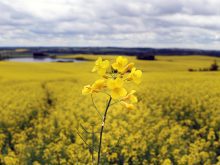LETHBRIDGE – This year’s cold, dry spring has taken a toll on Alberta crops.
Most of the province has received less than half its normal April and May precipitation, which has delayed crops.
Less than 30 millilitres of rain have fallen from Edmonton to Lethbridge in May. April was also colder than normal, and precipitation arrived as snow.
“The big benefit for snows was really in the foothills,” said agronomist Ross McKenzie of Agriculture Canada’s research centre in Lethbridge.
However, despite the lack of moisture, dryland crops in the Lethbridge region look reasonably good.
Read Also

Machinery automation runs through 2025 Agritechnica innovation awards
Computer vision and AI processing for farm machinery show up many times in Agritechnica’s 2025 innovation award winners.
“Soil moisture this spring was 12 to 18 inches of moist soil. This translates into two to three inches of actual moisture. That would have been in early April,” he said.
“We need some significant rains in the next couple weeks. We don’t really have additional moisture to keep things going.”
McKenzie is an advocate of early seeding so crops can take advantage of the longer growing days of June to yield more. His plots were seeded April 9, April 26, May 11 and May 25.
“For all the cereals, we are looking at somewhere between 25 and 40 percent reduction in yields as we delay seeding,” he said.
However, cold weather affects germination. For example, at 20 C, barley takes six to seven days to germinate and emerge. At 10 C, plants takes 12 to 15 days and at 5 C it takes 25 to 28 days for germination and emergence.
“That would give you a sense of why it has been so long, especially in April, that it took so darn long for crops to emerge,” McKenzie said.
Spraying for insect pests and diseases during cold spells should be monitored to get the most benefit, say scientists at the Lethbridge centre.
“Generally dry conditions mean conditions that are not good for diseases,” said plant pathologist Denis Gaudet.
However, stripe rust was at epidemic levels in 2006 and all wheat varieties are susceptible.
“It is always around despite the fact there isn’t a lot of rain,” he said.
“The dews in the morning and condensation of water on the leaves is sufficient to get disease going and once it is established, it can move very quickly.”
Cool mornings and heavy dews could continue in June, so Gaudet recommends being ready with a fungicide treatment or risk losing the entire crop.
Spraying weeds in cool weather could be trouble, said weed scientist Bob Blackshaw.
“We are so used to not seeing crop injury. We used to see it all the time with our older herbicides.
“Now, we assume we are going to have fantastic crop tolerance, and that will not be the case with cold temperatures or frost.”
Most crops tolerate the herbicide because they metabolize the chemicals into an inactive form within a few hours.
“What happens when you get cool temperatures, that crop is not growing, and especially if you get close to a frost temperature it is in a shock mode. So then it takes a day or two to recover,” Blackshaw said. “If we have those cold temperatures, you need to think a little bit about what the temperature is going to be the next day.”
He recommends spraying on a sunny day with temperatures above 10 C. If a frost occurs, wait a couple days before spraying.
“Weeds need to be actively growing to be killed well,” he said.















